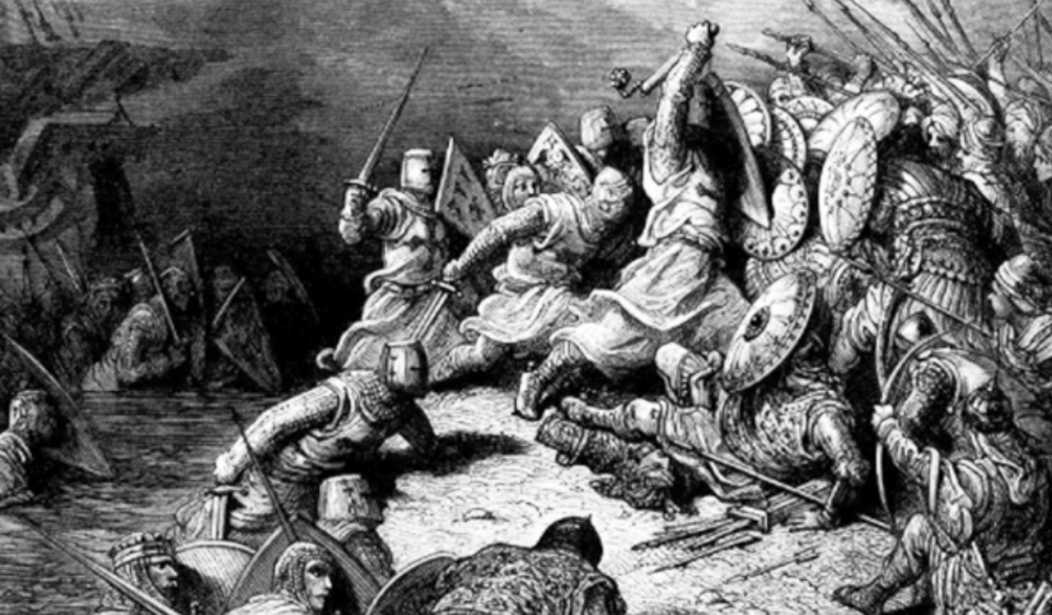Today in history, a small band of Christian warriors defeated a massive horde of Muslims.
On July 27, 1192, Saladin, the great sultan-hero of Islam, surrounded and besieged the tiny Christian-held town of Jaffa. According to contemporary chronicles, the Muslims numbered as much as 20,000 and “covered the face of the earth like locusts.”
Messengers were instantly dispatched to King Richard I, who was then in Acre, preparing to sail back to England. Before the battered and bruised men had finished relaying their message, “With God as my guide,” Richard declared, “I will set out to do what I can,” and instantly disembarked on his fleet with slightly over 2,000 fighters.
Jaffa, meanwhile, was fighting for its life. According to Saladin’s court historian, Baha’ al-Din, who was present, after one of its walls collapsed, all the Muslims rushed into the city, “and there was not an enemy heart that did not tremble and shake.” Even so, the Christians “were more fierce and determined in the fight and more eager for and devoted to death.”
When the main gate was finally battered down and an adjoining wall collapsed from the bombardment, a “cloud of dust and smoke went up and darkened the sky.” Once it cleared, the Muslims saw that “spear-points had replaced the walls and lances had blocked the breach.” Only death would release the crusaders of their charge to defend Jaffa.
Due to the great masses of rushing Muslims, the garrison was eventually driven to and holed up in the citadel, even as the sackers turned their attention to Jaffa’s civilian populace: “Alas for the pitiful slaughter of the sick!” recalls a chronicler. “They lay weakly on couches everywhere in the houses of the city; the Turks tortured them to death in horrible ways.”
Richard’s fleets finally arrived on the evening of July 31, but did not disembark. As Baha’ al-Din explains, the crusaders “saw the town crammed with the Muslims’ banners and men and they feared that the citadel might have already been taken. The sea prevented their hearing the shouts that came from everywhere and the great commotion and cries of ‘There is no god but Allah’ and ‘Allahu Akbar.’”
To make matters worse, “When the Turks saw the king’s galleys and ships approaching, masses of them ran on to the shore,” writes a chronicler, “raining down spears, javelins, darts and arrows densely so that they would have nowhere free to land. The shore was seething, so covered with crowds of the enemy that there was no empty space left.”
Then, on the morning of August 1, a fighting priest took his chances: he jumped out of the citadel’s window, into the sea, and swam to the fleets. On learning that, although the “Saracens had taken the castle and were rounding up the Christians as prisoners,” a remnant of the garrison was still holding out, Richard exclaimed that, “If it so please God … we should die here with our brothers.”
Without donning his full armor, and in the words of the chroniclers, the king “armed himself with his hauberk, hung his shield at his neck and took a Danish axe in his hand.” With his crossbow in the other hand—and crying “death only to those who do not advance!”—he hurled himself into the water “and forced himself powerfully on to dry land,” all while firing his crossbow at the wild throng assembled along the shore and swiping incoming arrows away with his axe.
Instantly, the rest of the crusaders followed their king; they hurled themselves into the water and “boldly attacked the Turks who obstinately opposed them on the shore.” Before long, and “at the sight of the king,” whom the Muslims dreaded from earlier encounters, none of them “dare[d] approach him.” Rather, they fled down the shore. A chronicle has the rest:
Brandishing his bared sword, the king followed in such hot pursuit that none of them had time to defend themselves. They fled from his weighty blows. In the same way the king’s comrades constantly assailed the fugitives, driving them on, crushing, rending, beheading and tossing them about until all the Turks had been violently expelled from the shore and left it empty…. The king fell on them with unsheathed sword, pursued them, beheaded and slew them. They fled before him, falling back in dense crowds to his right and left.
Once Richard, drenched in Muslim blood, became visible to Saladin’s entourage, “a horrible howl went up,” even as Turkic arrows rained on the Christians. Undeterred, their berserker king continued to “cut to pieces all he met without distinction” in his mad dash to Saladin, prompting the sultan to dash “like a frightened hare… [H]e put spur to horse and fled before King Richard, not wishing to be seen by him…. The king and his fellow-knights steadfastly pursued him, continually slaying and unhorsing … for more than two miles.”
It was a disorderly retreat and rout of the most ignoble kind; and it was the most humiliating defeat the great Saladin, who died months after, ever suffered.
Indeed, due to his exploits at Jaffa and elsewhere, it is the name of Richard Lionheart that, in the popular Muslim consciousness, most personifies the archetypal crusader enemy till this very day—a testimony to the havoc he wrought singlehandedly.
This article was excerpted from Raymond Ibrahim’s new book, Defenders of the West: The Christian Heroes Who Stood Against Islam, which has a complete chapter on King Richard.










Join the conversation as a VIP Member